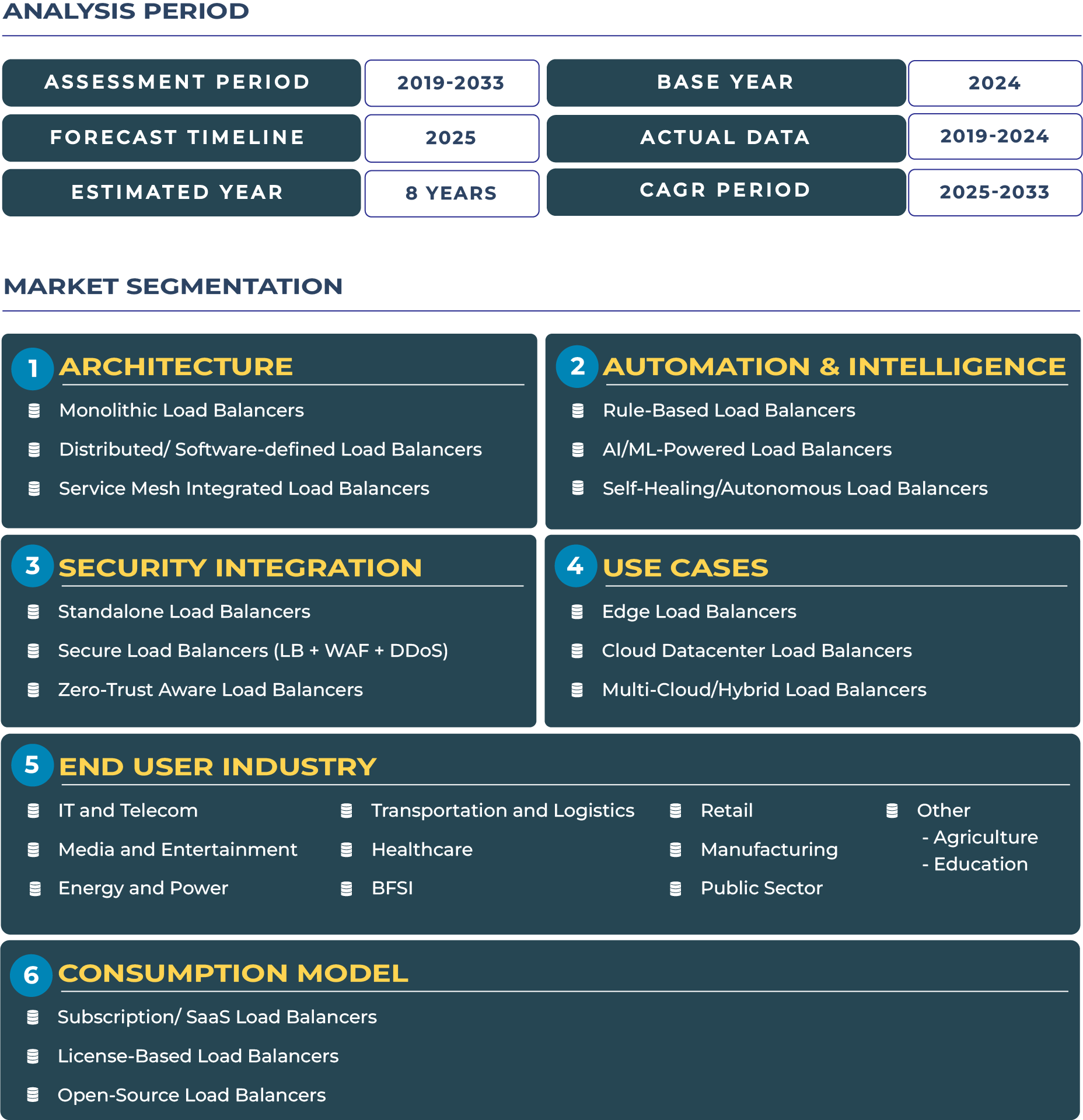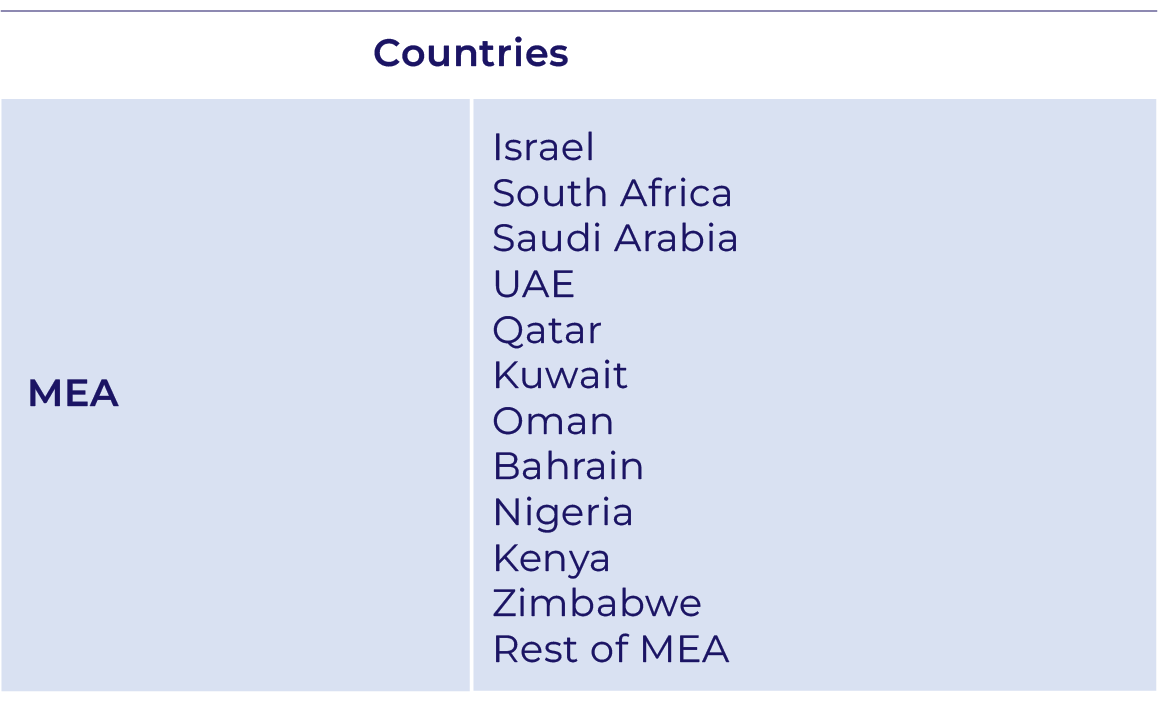Report Format:
![]()
![]() |
Pages: 160+
|
Pages: 160+
MEA Cloud Load Balancers Market: Fragmented yet Fast-Evolving with Government-Backed Agendas
The Middle East and Africa (MEA) cloud load balancers market represents a fragmented yet fast-evolving digital landscape, driven by government-backed cloud strategies and hyperscaler entry across multiple sub-regions. In 2025, the market is valued at USD 77.4 million and is projected to reach USD 241.9 million by 2033, reflecting a CAGR of 15.3% from 2025 to 2033. This growth is anchored by sovereign cloud agendas, large-scale telco investments, and rising demand for compliance-ready infrastructure across diverse economies. While Gulf states like Saudi Arabia and the UAE are accelerating adoption with strong regulatory frameworks, African nations are increasingly embracing mobile-first ecosystems and digital banking services, creating fertile ground for distributed and service mesh-integrated load balancers. The MEA market’s heterogeneity requires tailored approaches, yet it is precisely this fragmented maturity that creates opportunities for innovation and differentiated strategies.
Growth Catalysts: How Gulf Digitization and African Mobile-First Momentum Drive Adoption
The MEA cloud load balancers industry benefits from multiple growth drivers. Gulf nations, particularly Saudi Arabia, UAE, and Qatar, are prioritizing sovereign cloud strategies as part of national digital transformation programs. Initiatives such as Saudi CITC frameworks for cloud services and the UAE’s digital government policy enhance trust in compliance-driven load balancer solutions. In Africa, mobile-first ecosystems are fueling adoption, with Nigeria and Kenya leading fintech growth that relies on scalable, secure, and highly available cloud-native architectures. Telcos in South Africa and Egypt are also investing heavily in edge and distributed infrastructure to handle industrial IoT, mobile banking, and smart city use cases. These forces collectively ensure robust demand for both software-defined and service mesh integrated load balancers across verticals.
Constraints in MEA: Why Fragmented Maturity and Political Risks Slow Down the Pace
Despite promising growth, several constraints hinder the MEA cloud load balancers sector. The fragmented maturity across the region, where Gulf states demonstrate advanced adoption but several African markets remain nascent, creates uneven opportunities. Political instability and macroeconomic risks in certain African and Middle Eastern countries continue to dampen investor confidence. Limited hyperscaler regions in Sub-Saharan Africa constrain the availability of globally competitive infrastructure, while data localization and sovereignty requirements raise compliance complexity. Moreover, the reliance on commodity-linked economies exposes ICT investment cycles to fluctuations in oil and mining revenues. Bridging these structural gaps will require regional collaboration, public-private partnerships, and localized architectures such as sovereign-compliant distributed load balancers.
Trends and Opportunities Defining the Future of MEA Cloud Load Balancers Ecosystem
Key trends shaping the MEA cloud load balancers landscape include the rollout of sovereign cloud programs across the Gulf Cooperation Council (GCC), the rapid expansion of telco-led edge computing hubs in Africa, and the modernization of fintech infrastructures in countries like Nigeria, Kenya, and South Africa. These trends underscore the strategic importance of service mesh integrated load balancers for high-demand applications. On the opportunity side, sovereign-compliant load balancing stacks are becoming critical to align with national data protection laws, while African telcos and managed service providers (MSPs) are finding opportunities to build regional cloud-native ecosystems. Events-driven smart city deployments in Dubai and Doha, alongside telecom operator partnerships in Lagos and Johannesburg, provide fertile ground for industrial-grade, mission-critical load balancer solutions.
Regional Analysis by Country
Saudi Arabia
- Saudi Arabia is leading the GCC cloud load balancers market with strong sovereign cloud frameworks under Vision 2030. Government-backed initiatives through CITC ensure compliance and resilience, while energy, fintech, and government workloads increasingly demand advanced distributed load balancing solutions.
Kuwait
- Kuwait’s adoption of cloud load balancers is growing steadily, driven by banking modernization and regulatory reforms. The emphasis on digital banking and secure online services positions the country as a rising adopter of distributed and software-defined architectures.
UAE
- The UAE stands out for rapid innovation with Digital UAE initiatives. Multinationals and local enterprises increasingly rely on service mesh integrated load balancers to support fintech, retail, and e-government workloads with high performance and reliability.
Oman
- Oman is emerging as a strategic hub for sovereign cloud investments, with a growing emphasis on compliance-ready distributed load balancers. Its telco sector is expanding offerings to support regional enterprises and SMEs.
Bahrain
- Bahrain’s proactive regulatory stance, particularly its cloud-first policy, accelerates adoption of cloud load balancers in the financial services sector. AWS’s regional presence supports this momentum, enhancing resilience and scalability.
Qatar
- Qatar is integrating cloud load balancers into its smart city and mega-event infrastructure projects. The focus is on mission-critical, high-availability solutions that support smart transport and national security workloads.
South Africa
- South Africa anchors Sub-Saharan adoption with mature telco-led investments in cloud and edge infrastructure. Distributed and service mesh architectures are enabling scalability for fintech, IoT, and enterprise workloads.
Israel
- Israel’s advanced cybersecurity ecosystem complements the adoption of secure, software-defined load balancers. Its innovation-driven economy, supported by government programs, ensures growth in enterprise-grade cloud load balancing.
Nigeria
- Nigeria’s mobile-first economy drives demand for secure, distributed load balancers supporting fintech, e-commerce, and digital banking ecosystems. Local telcos are building resilient infrastructures to handle surging traffic volumes.
Kenya
- Kenya’s fintech-led ecosystem, anchored by mobile money platforms, requires scalable cloud load balancers. Nairobi’s rise as a digital hub in East Africa enhances opportunities for service mesh integration.
Zimbabwe
- Zimbabwe’s adoption is slower but steadily increasing due to financial inclusion and SME-led digitization. Service providers are experimenting with cost-effective distributed load balancers to support resilience.
Competitive Landscape: Tailored Go-to-Market Motions for GCC Enterprises and African Telcos
The competitive landscape of the MEA cloud load balancers sector is defined by a two-track approach: GCC markets focus on high-compliance enterprise-grade solutions, while African telcos and MSPs push managed offerings tailored for SMEs and mobile-first economies. Global providers such as F5 and local telcos like MTN and Etisalat are strengthening presence through partnerships, while sovereign-driven initiatives bring regional players into the fold. In 2024, partnerships between hyperscalers and GCC governments highlight the need for sovereign-compliant architectures, whereas in Africa, telco-MSP managed services dominate. This dual pathway creates a diverse but competitive landscape, positioning MEA as one of the most dynamic frontiers for cloud load balancer providers.








